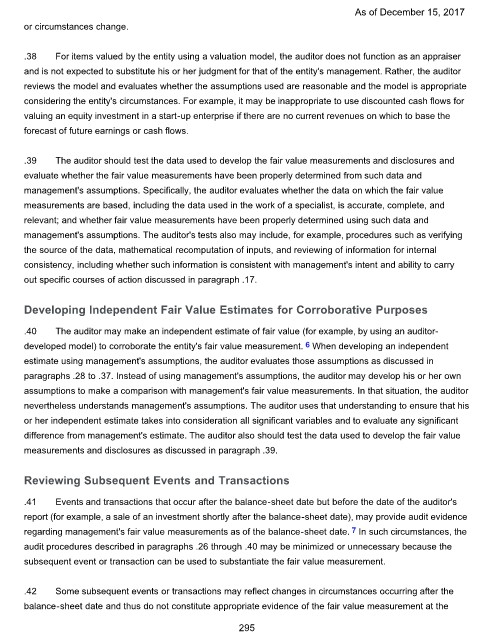Page 298 - Auditing Standards
P. 298
As of December 15, 2017
or circumstances change.
.38 For items valued by the entity using a valuation model, the auditor does not function as an appraiser
and is not expected to substitute his or her judgment for that of the entity's management. Rather, the auditor
reviews the model and evaluates whether the assumptions used are reasonable and the model is appropriate
considering the entity's circumstances. For example, it may be inappropriate to use discounted cash flows for
valuing an equity investment in a start-up enterprise if there are no current revenues on which to base the
forecast of future earnings or cash flows.
.39 The auditor should test the data used to develop the fair value measurements and disclosures and
evaluate whether the fair value measurements have been properly determined from such data and
management's assumptions. Specifically, the auditor evaluates whether the data on which the fair value
measurements are based, including the data used in the work of a specialist, is accurate, complete, and
relevant; and whether fair value measurements have been properly determined using such data and
management's assumptions. The auditor's tests also may include, for example, procedures such as verifying
the source of the data, mathematical recomputation of inputs, and reviewing of information for internal
consistency, including whether such information is consistent with management's intent and ability to carry
out specific courses of action discussed in paragraph .17.
Developing Independent Fair Value Estimates for Corroborative Purposes
.40 The auditor may make an independent estimate of fair value (for example, by using an auditor-
6
developed model) to corroborate the entity's fair value measurement. When developing an independent
estimate using management's assumptions, the auditor evaluates those assumptions as discussed in
paragraphs .28 to .37. Instead of using management's assumptions, the auditor may develop his or her own
assumptions to make a comparison with management's fair value measurements. In that situation, the auditor
nevertheless understands management's assumptions. The auditor uses that understanding to ensure that his
or her independent estimate takes into consideration all significant variables and to evaluate any significant
difference from management's estimate. The auditor also should test the data used to develop the fair value
measurements and disclosures as discussed in paragraph .39.
Reviewing Subsequent Events and Transactions
.41 Events and transactions that occur after the balance-sheet date but before the date of the auditor's
report (for example, a sale of an investment shortly after the balance-sheet date), may provide audit evidence
7
regarding management's fair value measurements as of the balance-sheet date. In such circumstances, the
audit procedures described in paragraphs .26 through .40 may be minimized or unnecessary because the
subsequent event or transaction can be used to substantiate the fair value measurement.
.42 Some subsequent events or transactions may reflect changes in circumstances occurring after the
balance-sheet date and thus do not constitute appropriate evidence of the fair value measurement at the
295

